~ THE TURNING OF THE WHEEL ~
Feast of Bread 2011
Leather Bound Limited Edition of Issues #5–8 + CD!
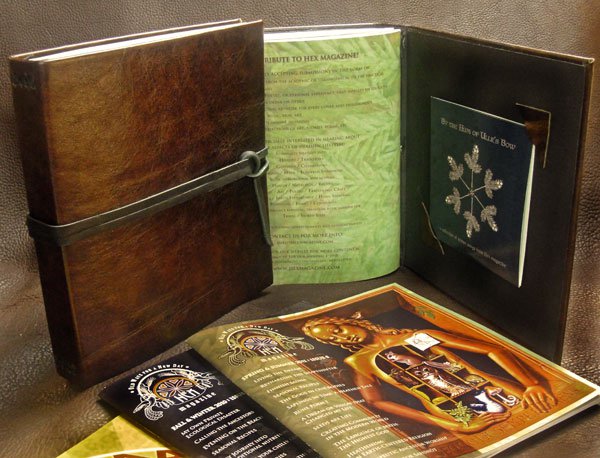
An edition of 13, and signed by the artisan (Jason Hovatter) and editors of Hex. One copy is very, very special (see photograph below).
Each copy is $100 + shipping, except the special edition which is $150 + shipping. If you want to order send me an email: arrowyn@hexmagazine.com. It’s first come…first serve!
Note: Issue #5 is sold out…this is a small reprint run.
All proceeds go to Hex Press to support its continued effort to provide folks with an excellent volunteer-based, community-supported, not-for-profit publication.

* * * * * *
And don’t forget: the much anticipated Hex Folk Market (www.hexfolkmarket.com) is here! Join our online market community in celebration of folk ways and sustainable living. Browse through our selection of international merchants or set up your own shop for free!
* * * * * *
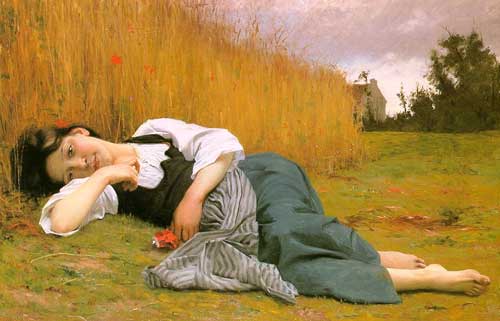
Rest at Harvest by William-Adolphe Bouguereau, 1825-1905
Harvest Month
August has arrived! For Heathen Households it’s time for celebrating Frey Faxi – or Lammas, Loaf Mass, Harvest, Weed Month, Hay Month, Maed–Month and more, depending on what Heathen tradition you may follow.
As the harvest season begins I’m getting some great hauls from the garden: squash, cucumbers, peppers, and grapes this week. However, when I think of the Harvest season and Heathenry, it is grains that come to mind. Grains were important to the Heathen Hearth for both animal and human nutrition. They were also a food grown at home that, when properly stored, could be saved for future use, even for many years.
The Old World Heathens didn’t consume just any old grains, however. They specifically ate whole grains, which today many of us lack in our diets.
A Brief History of Grains
12,000 BCE: Cereal grains grown in the Fertile Crescent; these “Neolithic founder crops” included emmer wheat, einkorn wheat, and barley.
8,000 BCE: Evidence of grain and flat bread use in Egypt.
1,050 BCE: Barley and Oats are grown in southern England.
500 BCE: Wheat becomes more popular in Britain.
500 CE: Saxons and Danes introduce rye to Britain, where dark rye bread soon becomes a staple.
500 CE: British bakers began to sell breads and create guilds. This led to regulations regarding price and weight.
1,066 CE: Hair sieves were first used to sift grains more efficiently, ultimately leading to varying degrees of “refined” white (fiberless) flours and breads.
2,011 CE: Grains are a worldwide staple, but almost universally in heavily refined, denatured forms.
Today most of us consume grains on a regular basis. We have a whole aisle in the grocery store full of ready-made cereals, and another offering a variety of plastic wrapped breads. There’s no denying the influence of the US Food Pyramid, which until recently recommended that we consume 6 to 11 servings of breads, cereals, rice, and/or pasta a day.
Unfortunately many of the grains we eat today are industrially refined and processed in health-damaging ways, and we’ve wandered far from the way our ancestors consumed them. Even products labeled “whole grain” are sometimes not what they seem. The first ingredient may be “whole wheat” as you look further down the list of ingredients you might find other fiber products have been added. Unless the label states 100% whole wheat it probably isn’t (and you should probably avoid it).
So what distinguishes whole grains? Well, they contain three parts. Firstly the bran, the outside coating or shell which contains fiber, vitamins, and minerals. Then the endosperm, a complex carbohydrate wrapped in protein. Finally the germ, which is the seed and capable of sprouting; this contains fat, protein, and vitamins.
Most readily available grain products these days lack the bran and germ, which have been “refined” out. This results in a loss of valuable nutrients, fiber, and antioxidants that our body needs. Such flour is therefore “enriched:” token nutrients are added to replace the lost nutrition, albeit not always in a form that can actually be digested. Refined grains can also have detrimental effects on blood sugar and insulin regulation, but that’s beyond the scope of this article.
Heathen Households (and most others for that matter) can benefit from replacing the refined grains in their diet with 100% whole grains. One way to do this is through whole wheat breads and whole grain cereals. This means you must read labels carefully to be sure you’re getting what you want.
As mentioned, be sure to read the ingredient list and look for “100% whole wheat” as the first ingredient, but also look for a fiber count of at least 2 or more grams per ounce. Of course ingredients on the list that you don’t recognize (because of their mysterious chemical names, for example) you probably don’t need. Keep an eye out for added sugar, high fructose corn syrup, and similar nasties, too.
For people who have lived their life consuming white bread, white rice, and white pasta, adapting to whole grains can be a challenge. The good news is that in our household’s experience the more you eat whole grains the better they taste and the less you desire the refined, “non-food” versions!
Meanwhile, the modern diet might be dominated by denatured and unhealthy refined grains, but some positive change is happening in official circles. For example with the help of Mrs. Obama and her campaign for healthier food for our children, this year a healthier government guideline has emerged – the “MyPlate” concept (http://www.choosemyplate.gov/).
The MyPlate concept is intended to be a guide to what foods to eat. It isn’t perfect, but it does emphasize whole grains over refined grains and reduces the excessive grain intake recommendations made by the infamous grain lobby-inspired food pyramid.
Soaking and Fermenting Grains
There’s another important aspect to grains that almost everyone neglects these days at the expense of their health.
While reading Sally Fallon’s popular cookbook Nourishing Traditions (available at http://amzn.to/19Jf4j) I learned that whole grains’ nutritional value is far more complicated than just being a good supplier of indigestible (and, to a certain extent, healthy) bran. Whole grains also contain less healthy ingredients like phytic acid, which can enter the intestinal tract and block absorption of several valuable minerals. This can in turn lead to nutritional deficiencies and bone loss.
Apparently grain producing cultures learned early to soak and/or ferment grain with water and a small amount of something like whey, yogurt, kefir, buttermilk, or even lemon or vinegar. This would neutralize the phytic acid – and hence the signs of indigestion they probably felt when the grains were not soaked or fermented.
In the past soaked or fermented whole grains would have been cooked and then probably kept in the kitchen as a type of fast food: handily ready to eat, just like we’d reuse leftover cooked rice or other grains today.
When grains are treated to a good soaking or fermentation they provide more readily digestible vitamins, especially B vitamin (which are missing or else “replaced” in refined grains). Soaking and fermentation also allow the glutens in many grains to become easier to digest, which means they also causes less gas.
Early bread makers achieved similar results by fermenting or slow rising their breads. Sourdough bread is a good example of a fermented or slow rise bread. Another method used to make grains more digestible is by sprouting the grain, but that’s another essay.
I’ve tried this soaking/fermenting process with oats and it is delicious. I’ve also tried soaking brown rice and must report it was the best brown rice I have ever eaten! The Nourishing Traditions method for making porridge is so easy, so good, and so nutritious – you must try it!
Traditionally at this time of year Heathen Households would use their Whole Grains in the form of porridge or bread as a blessing and offering. They were known to share it with the Gods and Goddesses suitable to their household. They were also known to place pieces of bread in the corners of rooms and barns, or to sprinkle it around the house for luck. Whatever your Heathen Household does at this time of year – be sure to include some whole grains; your body will thank you!
BREAKFAST PORRIDGE
Serves 4
1 cup oats, rolled or cracked
1 cup warm filtered water plus 2 tablespoons whey, yoghurt, kefir, or buttermilk (for milk allergies use lemon juice or vinegar)
1/2 teaspoon sea salt
1 cup filtered water
1 tablespoon fresh ground flax seeds (optional) [NOTE: I love ground flaxseed, it adds a nutty flavor]
Soak oats in water mixture in a warm place, covered, at least 7 hours and up to 24 hours. Heat 1 cup water with sea salt to boiling. Add soaked oats, reduce heat, cover and simmer circa 5 minutes. Add ground flax seed and remove from heat. Let stand for a few minutes. Serve with butter, cream and natural sweeteners.
Try adding fruit butters, nuts, dried fruits, coconut, and anything else that might be good. Nourishing Traditions contains versions of porridge adapted for using Kamut, Spelt, Rye, Teff, Amaranth, and even Grits to make this porridge! Each has slight variations in its preparations.
If you have leftovers, you can make –
FRIED MUSH
Makes 3 patties
1 1/2 cups leftover breakfast porridge or grits [or brown rice]
1 egg, lightly beaten
2 tablespoons butter or lard
Mix porridge with egg. Sauté by 1/2 cup portions in fat until golden and the edges are crispy. Serve with maple syrup, sorghum syrup, agave, honey, or other natural sweetener.
August Highlights:
7/14 – 8/19 (7/28 peaks): Delta Aquarid Meteor Shower. Best viewed after midnight to early morning, look south. Expect 10 meteors per hour at peak.
7/29 – 8/17 (8/12 peaks): Perseid Meteor Shower. Best viewed after midnight to early morning, look northeast. This is one of the most prolific of the year with upwards of 50 meteors an hour expected at peak, however the full moon will make the lighter ones less visible.
7/30 – 8/5: Iroquois Green Corn Ceremony.
7/31 – 8/2: Look for the first glimpse of the Crescent moon at sunset at this time.
7/31 – 8/7: First Harvest/Lammas celebration of the first grain harvest.
7/31- 8/2: Lughnasadh an Old Celtic/Irish feast in honor of the Goddess Tailtiu and the God Lugh.
8/2: Look for the planet Jupiter, which will look like a brilliant star, after midnight and again at first light in the southeastern sky.
8/3: Look for the planet Saturn in the constellation Virgo.
8/6: First quarter moon rises around midday and sets around midnight. Moon is 1/2 full.
8/9: King Radbod of Frisia is remembered for refusing baptism when learning he would not join his ancestors after his death.
8/13: Full moon.
8/20: (1994) Birth of the White Buffalo.
8/21: Last quarter moon – Moon is 1/2 full.
8/23: Thing’s Tide (not to be confused with the Icelandic Althing) Many honor Týr on this day and tend to kindred business.
8/26 (1920): 19th Amendment to Constitution giving women the right to vote.
8/29: New moon.
~ Teresa L. Hedgewife
* * * * * *
~ Call for Submissions ~
Hex Magazine is always seeking fresh contributions! We’re keen both to nurture new talent and to honor established thinkers!
Join us: Submissions for Issue 10 (Spring 2011)
due Autumn Equinox 2011.
Submission guidelines are available at
http://hexmagazine.com/submit/guidelines/
Feeling Hexy?
Hex is putting out an initial call for Heathen Erotica.
For a side project, not a regular issue.
It will be published when we get enough material.
Accepting submissions for stories, poetry, art, photography, recipes, whatever. You can submit under your own name or a nom de plume.
The usual high standards of quality apply! IE: if it’s smut, it better be really good smut!
Send submissions to submissions@hexmagazine.com
* * * * * *

•TEIWAZ•
Old English Rune Poem
Tir is a particular token; it holds trust well
with noble folk; it is ever on a journey
over nights’ mists; it never deceives.
Old Icelandic Rune Poem
Tyr is a one-handed god
and wolf’s leftovers
and the temple’s chief.
Old Norwegian Rune Poem
Tyr is a one-handed god;
oft will a smith be blowing.
~ Rune poem translations by Sweyn Plowright
http://www.mackaos.com.au/Rune-Net/Primer/
The story of the one-handed god of Norse mythology is the stuff of heroic tragedy. Faced with the threat of the ever-growing, ever voracious Fenris Wolf, the gods gather to bind the great beast. Yet Fenris is no fool, and when the gods challenge him to a test of strength – “go on, try on these here big, heavy chains” – tension mounts rapidly.
The wolf at first goes along with the ruse, snapping every bond applied to him. Soon enough, however, he decides that he is unwilling to continue the game without a pledge of good faith: one of the gods must place their hand in his mouth as security should he find himself unable to break their chains.
Tyr volunteers and places his hand in the slavering maw; the next set of bonds prove too strong for the wolf; Fenris vents his fury with a tremendous chomp that leaves Tyr lop-sided forever more.
Traditionally this story is taken to be a reflection on the tragedy of sacrificing oneself for one’s community. Tyr is never again going to compete in an archery tournament or play another round of golf, and in return his people are spared the threat of Fenris’s depredations. He is left to suffer his loss with no more to show for it than those who (literally) lifted not a finger.
Yet sometimes it seems fitting to question the way that a myth is interpreted. Should serving our community really be about one-sided loss? What good is a community which takes from its members and gives little directly in return? Is this model of community service even an adequate reflection of the experience of selfless action?
If you’ve ever done volunteer work that is well-suited to your interests and personality – particularly in support of those who are struggling with life’s hardships – you might discover something. Namely that giving without expectation of reward is, ironically, deeply rewarding.
Some of the most profoundly special experiences of my life occurred while I was serving others with no thought of my own interests, and I am sure I am not the only one. It goes beyond mere emotions and deep into territory I would describe as spiritual.
When we give to our community it might be our time or energy that we sacrifice, but I believe that, contra the usual reading of the myth of Fenris and Tyr, we tend to get back more than what we give (so long, as I say, we’re doing something for which we have a personal affinity).
It is almost as though new energy is created out of nowhere when the exchange of altruistic action happens. Through my care, respect, compassion, action towards another I discover my own sense of inspiration and healing. I become empowered, yet centred and sober. I become less naïve, perhaps, about the world, yet also less perturbed by its arbitrariness and cruelty.
And strangely, this alchemy does not seem to manifest in the same way through, say, donating money to a good cause. Such an action does feel satisfying, to be sure (particularly if one does not otherwise have time, skills, or energy to donate), but to see change in another human being (or animal, or natural place) as a direct result of one’s own actions is much more powerful.
As such, I can only conclude that Tyr has been poorly understood. The knowledge that he has protected those who will otherwise be destroyed must be tremendously healing – if divine psychology is anything like human psychology then it is possible that Tyr’s sacrifice makes him more and not less than his fellows.
I suppose underlying these reflections is the oft-discussed tension between the mindsets of abundance and scarcity. In the clutch of fear we clamp down on our generosity – yet this merely erodes our spirits further. There’s danger in giving more than one has, or giving in a way that is harmful to oneself, of course – but on the whole generosity brings well-being. And we know this to be a value celebrated in Northern Mythology.
If Tir is a token – a star – that never fails, then perhaps his infallibility stems precisely from his generous open-handedness (if you’ll pardon the pun). He exemplifies the truth that sometimes by serving others we can heal ourselves; and this rune invites each of us to ask how we might nourish ourselves more completely by embracing the seeming loss of selfless service to others.
* * * * * *
Support Hex! We are community-supported not-for-profit publication. You can support us by heading to http://hexmagazine.com/subscribe/ and ordering magazines, CDs, and prints, and by spreading the word to all like-minded folk!
* * * * * *
By the Hum of Ullr’s Bow: Winter Songs Compilation CD
is still available!
Bands on the compilation CD include:
• A Minority of One • Allerseelen • Andrew King • At the Head of the Woods
• Beastianity • Hamramr • Irij • Ironwood • Ruhr Hunter
• Sangre Cavallum • Sieben • Steve von Till
• Svarrogh • Waldteufel • Wardruna
(You can read more about the artists here:
http://hexmagazine.com/harvest/winter-songs-cd/).
* * * * * *
: Issue Three Almost Gone! :
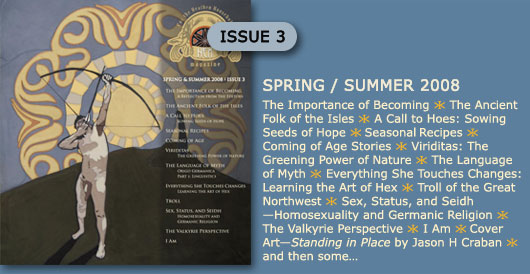
Issues One, Two, Four, & Five are sold out!
Limited numbers of Hex Issue Three (and also issues Six, Seven, and Eight of course) remain…
Order at:
* * * * * *
Until Autumn Equinox, may you and your
household be blessed and kept. Hail!
~ HEX Magazine
* * * * * *
We are currently looking for:
• submissions
• funding
If you are interested in applying or have any suggestions,
contact: info@hexmagazine.com
* * * * * *
Due date for Spring 2012 submissions
is Autumn Equinox 2011
Support your community while exposing like-minded
folk to your goods and services…
Advertisements must be relevant to HEX readers, and inclined toward a Heathen aesthetic. Prices listedare for completed AD files. If you need additional graphic design, we can help. Just contact us about our design fee.
AD space is now available in the newsletter for $10 a run.
Contact info@hexmagazine.com if you are interested.
>I< HEX >I<
> Please forward to all interested and relevant parties <



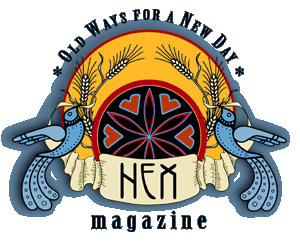
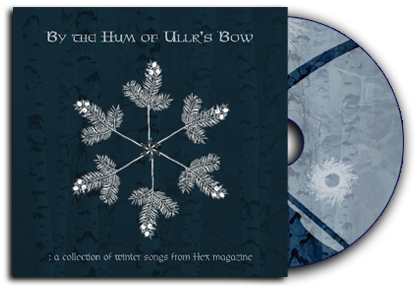






Leave a Reply